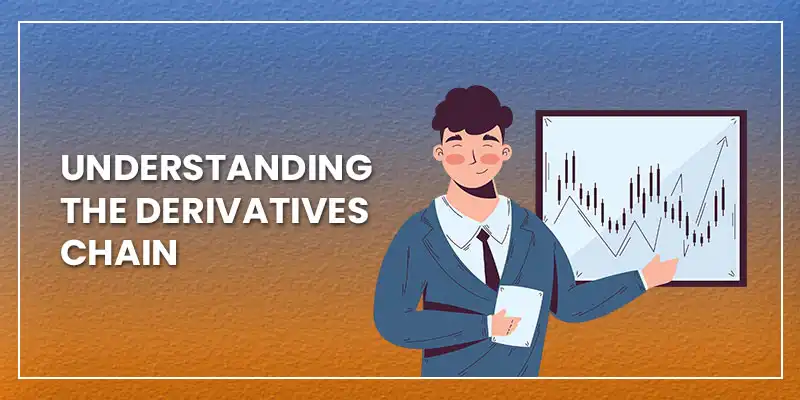Derivatives trading in futures and options represents a complex financial market segment where contracts derive value from underlying assets. In this context, a derivatives chain refers to a sequence of related contracts with differing characteristics. This article outlines key concepts in futures and options trading and the structure of the derivatives chain. The goal is to promote awareness of risk, mechanics, and market interconnections, without suggesting any specific outcomes or strategies.
Contents
- Understanding the Derivatives Chain
- Futures Trading Overview
- Options Trading Overview
- Trading Strategies
- Risk Management
- Conclusion
- FAQs
Understanding the Derivatives Chain
A derivatives chain represents a sequence of contracts linked by similar characteristics or underlying assets. The chain may include instruments with varying expiration dates, strike prices, or premium structures. Analyzing the chain allows market participants to understand the progression from simpler contracts to more complex derivatives. Studying the links can help in understanding contract structures; however, derivatives trading is complex and should be approached with caution, especially when evaluating multi-leg instruments.
Read Also: Essential Risk Management Techniques for F&O Trading
Futures Trading Overview
Futures contracts are standardized agreements to buy or sell an underlying asset at a predetermined price on a future date. These contracts are traded on regulated exchanges, ensuring transparency and liquidity. Both parties agree to the contract’s terms at the start of a trade. The daily mark-to-market process adjusts account balances based on price movements. This mechanism helps maintain market equilibrium by reflecting real-time price changes and reducing counterparty risk.
Futures trading involves significant risk and may not be suitable for all investors. Exposure is leveraged, which can amplify both gains and losses.
Futures trading involves significant risk and may not be suitable for all investors. Exposure is leveraged, which can amplify both gains and losses.
Options Trading Overview
Options provide the right—but not the obligation—to buy or sell an underlying asset at a specific strike price within a defined period. There are two primary types: call options, which confer the right to purchase and put options, which confer the right to sell. The premium paid for an option reflects market views regarding volatility and the remaining time until expiration. Participants should carefully assess the obligations and risks associated with both writing and purchasing options, as these contracts can result in substantial losses if market conditions move unfavorably.
Trading Strategies
Multiple strategies exist in derivatives trading.
- Directional Strategies: Involve speculative positions on price movements, but can result in a loss if the market moves contrary to the trader’s view.
- Spread Strategies: Seek to capitalize on pricing differences between related contracts, but require careful execution and risk awareness.
- Hedging Strategies: Traders may use derivatives to offset potential losses in other portfolio positions, aiming to reduce overall market exposure.
- Arbitrage Strategies: Aim to exploit temporary pricing discrepancies. Execution risk and capital requirement should be considered before participating.
- Volatility-Based Strategies: Rely on market volatility estimates and often use complex combinations; these may carry higher risk due to multiple contract legs.
- Note: The above strategies are mentioned solely for educational reference. They are not intended as recommendations. Traders should consult a qualified financial advisor before considering any approach.
Risk Management
Effective risk management in derivatives trading entails continuous monitoring of positions and market conditions. Traders should establish clear limits on exposure and utilize margin requirements to minimize potential losses. Regular market liquidity and volatility assessment is crucial, ensuring that trading decisions align with defined risk parameters.
Risk cannot be fully eliminated in derivatives trading. Measures such as stop-loss orders, portfolio diversification, and continuous monitoring may reduce exposure but do not guarantee against losses.
Employing stop-loss orders, diversifying positions, and setting realistic profit targets contribute to managing downside risks. Traders must review all strategies periodically to ensure they remain effective under changing market dynamics, enabling quick adaptability to unforeseen events while preserving capital integrity.
Participants are advised to maintain a sufficient margin, monitor contracts regularly, and avoid trading beyond their risk capacity.
Read Also: An Overview of Exotic Options in Financial Market
Conclusion
Derivatives trading in futures and options is a multifaceted field that combines various financial instruments into an interconnected chain. Understanding the structure and relationships among these instruments is essential for comprehending market dynamics. This article has outlined the fundamentals of the derivatives chain and highlighted associated risks and the mechanics of trading futures and options. This content is intended to increase awareness and does not serve as investment advice. Investors must make informed decisions based on their risk profile and professional guidance.
Disclaimer: Educational Use Only: This content is for informational purposes and does not constitute financial advice or trading recommendations. Investment in the securities market is subject to market risks. Please read all scheme-related documents carefully before investing. The information provided in this article is for educational and informational purposes only and is not intended as investment advice. Trading in derivatives, including options, involves substantial risk and is not suitable for all investors. Past performance is not indicative of future results. Readers are advised to consult with their financial advisors before making any trading decisions.
FAQs
Market liquidity affects trade execution and transaction costs. High liquidity yields tighter spreads and better efficiency; low liquidity often results in wider spreads and slippage.
Tax treatment varies based on transaction type and holding period. Traders must review applicable tax laws and consult professionals for accurate, compliant tax reporting procedures. Regulatory disclosures and transaction types affect taxability; check SEBI and CBDT guidelines for updated norms.
Platforms vary in features, analytics, execution speed, and user interface. Evaluating multiple options can help identify a solution that effectively meets individual trading needs. Ensure the platform is SEBI-registered and offers robust risk disclosure tools.

